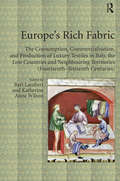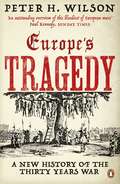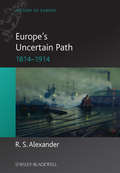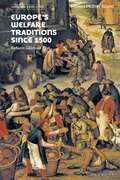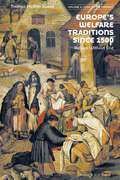- Table View
- List View
Europe's Orphan: The Future of the Euro and the Politics of Debt
by Martin SandbuOriginally conceived as part of a unifying vision for Europe, the euro is now viewed as a millstone around the neck of a continent crippled by vast debts, sluggish economies, and growing populist dissent. In Europe's Orphan, leading economic commentator Martin Sandbu presents a compelling defense of the euro. He argues that rather than blaming the euro for the political and economic failures in Europe since the global financial crisis, the responsibility lies firmly on the authorities of the eurozone and its member countries. The eurozone's self-inflicted financial calamities and economic decline resulted from a toxic cocktail of unforced policy errors by bankers, politicians, and bureaucrats; the unhealthy coziness between finance and governments; and, above all, an extreme unwillingness to restructure debt.Sandbu traces the origins of monetary union back to the desire for greater European unity after the Second World War. But the euro’s creation coincided with a credit bubble that governments chose not to rein in. Once the crisis hit, a battle of both ideas and interests led to the failure to aggressively restructure sovereign and bank debt. Ideologically informed choices set in motion dynamics that encouraged more economic mistakes and heightened political tensions within the eurozone. Sandbu concludes that the prevailing view that monetary union can only work with fiscal and political union is wrong and dangerous—and risks sending the continent into further political paralysis and economic stagnation.Contending that the euro has been wrongfully scapegoated for the eurozone’s troubles, Europe’s Orphan charts what actually must be done for the continent to achieve an economic and political recovery.This revised edition contains a new preface addressing the economic and political implications of Brexit, as well as updated text throughout. Europe’s Orphan charts what actually must be done for the continent to achieve a full recovery.
Europe's Postwar Periods - 1989, 1945, 1918: Writing History Backwards
by Martin Conway Pieter Lagrou Henry RoussoThis book brings together world-renowned scholars from all over Europe to analyse how successive Europes have been constructed in the wake of the key conflicts of the period: the Cold War and the two World Wars. By regressively tracing Europe's path back to these pivotal moments as part of a unique methodology, Europe's Postwar Periods - 1989, 1945, 1918 reveals the defining characteristics of these postwar periods and integrates the changes that followed 1989 into a more substantial historical perspective. The author team address the crucial themes in recent European history on a chapter-by-chapter basis that gives comprehensive coverage to the whole of the European region for topics such as borders, states, empires, democracy, justice, markets and futures. The volume highlights the fact that Europe was made less by wars than is commonly thought, and more by the nature of the settlements – international, national, political, economic and social – that followed the two World Wars and the Cold War. It is an important, innovative text for all students and scholars of 20th-century European history.
Europe's Postwar Periods - 1989, 1945, 1918: Writing History Backwards
by Martin Conway Pieter Lagrou Henry RoussoThis book brings together world-renowned scholars from all over Europe to analyse how successive Europes have been constructed in the wake of the key conflicts of the period: the Cold War and the two World Wars. By regressively tracing Europe's path back to these pivotal moments as part of a unique methodology, Europe's Postwar Periods - 1989, 1945, 1918 reveals the defining characteristics of these postwar periods and integrates the changes that followed 1989 into a more substantial historical perspective. The author team address the crucial themes in recent European history on a chapter-by-chapter basis that gives comprehensive coverage to the whole of the European region for topics such as borders, states, empires, democracy, justice, markets and futures. The volume highlights the fact that Europe was made less by wars than is commonly thought, and more by the nature of the settlements – international, national, political, economic and social – that followed the two World Wars and the Cold War. It is an important, innovative text for all students and scholars of 20th-century European history.
Europe's Prolonged Crisis: The Making or the Unmaking of a Political Union (PDF)
by Hans-Jörg Trenz Carlo Ruzza Virginie GuiraudonThis volume outlines a political sociology of crisis in Europe, focusing on state and society transformations in the context of the 2008 financial and monetary crisis and its aftermath in Europe. Dysfunctions of the market and the European economic and monetary system pose severe challenges to the legitimacy of political order at national, European and global level. In this collection, the contributors investigate how the crisis undermines the integrity of political institutions and democratic government at EU and member state level, and analyse how the experiences of social deprivation are translated into political conflict and cleavages across the European space. Evidence is provided for how the return of redistributive conflicts correlates with a 'new politics of identity', nationalism, regionalism and expressions of Euroscepticism. Crisis affects patterns of social exclusion but, as this book reveals, it can also activate social networks and impacts on new forms of solidarity,which are emerging locally and transnationally.
Europe's Red Terrorists: The Fighting Communist Organizations
by Yonah Alexander Dennis A. PluchinskyThis unique volume explores Europe's most dangerous communist terrorist organizations and reveals how they use violence as a means of political communication and persuasion. It outlines seven terrorist groups from Germany, Greece, Spain, France, Belgium, Italy and Turkey and gives their modus operandi, rationale and political messages in translated communiqués never before available in English.
Europe's Red Terrorists: The Fighting Communist Organizations
by Yonah Alexander Dennis A. PluchinskyThis unique volume explores Europe's most dangerous communist terrorist organizations and reveals how they use violence as a means of political communication and persuasion. It outlines seven terrorist groups from Germany, Greece, Spain, France, Belgium, Italy and Turkey and gives their modus operandi, rationale and political messages in translated communiqués never before available in English.
Europe's Relations with North Africa: Politics, Economics and Security (Library of European Studies)
by Adam YousefThe rapid evolution of events in the European, Middle Eastern, and North African spheres has reinvigorated the debate on Euro-Mediterranean relations. Since 1995 these relations have operated under the auspices of the Barcelona Process, which laid the foundations for three initiatives that define European policy towards neighbouring states: the Euro-Mediterranean Partnership, the European Neighbourhood Policy, and the Union for the Mediterranean. This book scrutinises these initiatives through a socioeconomic prism. Adam Yousef reviews how appropriate these initiatives have been in promoting socioeconomic development in North African states, projects the long-term implications of these policies and investigates whether they can reduce the gap in social outcomes across the Mediterranean Basin over time. Using Morocco as a case study, this book employs a mixed-methods approach, combining qualitative and quantitative data as well as economic theory. It reveals not only that the Barcelona Process has had a limited impact on promoting social outcomes in Morocco, but crucially that it is also unlikely to do so in the future, suggesting a new approach may be required.
Europe's Rich Fabric: The Consumption, Commercialisation, and Production of Luxury Textiles in Italy, the Low Countries and Neighbouring Territories (Fourteenth-Sixteenth Centuries)
by Bart Lambert Katherine Anne WilsonThroughout human history luxury textiles have been used as a marker of importance, power and distinction. Yet, as the essays in this collection make clear, the term 'luxury' is one that can be fraught with difficulties for historians. Focusing upon the consumption, commercialisation and production of luxury textiles in Italy and the Low Countries during the late medieval and early modern period, this volume offers a fascinating exploration of the varied and subtle ways that luxury could be interpreted and understood in the past. Beginning with the consumption of luxury textiles, it takes the reader on a journey back from the market place, to the commercialisation of rich fabrics by an international network of traders, before arriving at the workshop to explore the Italian and Burgundian world of production of damasks, silks and tapestries. The first part of the volume deals with the consumption of luxury textiles, through an investigation of courtly purchases, as well as urban and clerical markets, before the chapters in part two move on to explore the commercialisation of luxury textiles by merchants who facilitated their trade from the cities of Lucca, Florence and Venice. The third part then focusses upon manufacture, encouraging consideration of the concept of luxury during this period through the Italian silk industry and the production of high-quality woollens in the Low Countries. Graeme Small draws the various themes of the volume together in a conclusion that suggests profitable future avenues of research into this important subject.
Europe's Rich Fabric: The Consumption, Commercialisation, and Production of Luxury Textiles in Italy, the Low Countries and Neighbouring Territories (Fourteenth-Sixteenth Centuries)
by Bart Lambert Katherine Anne WilsonThroughout human history luxury textiles have been used as a marker of importance, power and distinction. Yet, as the essays in this collection make clear, the term 'luxury' is one that can be fraught with difficulties for historians. Focusing upon the consumption, commercialisation and production of luxury textiles in Italy and the Low Countries during the late medieval and early modern period, this volume offers a fascinating exploration of the varied and subtle ways that luxury could be interpreted and understood in the past. Beginning with the consumption of luxury textiles, it takes the reader on a journey back from the market place, to the commercialisation of rich fabrics by an international network of traders, before arriving at the workshop to explore the Italian and Burgundian world of production of damasks, silks and tapestries. The first part of the volume deals with the consumption of luxury textiles, through an investigation of courtly purchases, as well as urban and clerical markets, before the chapters in part two move on to explore the commercialisation of luxury textiles by merchants who facilitated their trade from the cities of Lucca, Florence and Venice. The third part then focusses upon manufacture, encouraging consideration of the concept of luxury during this period through the Italian silk industry and the production of high-quality woollens in the Low Countries. Graeme Small draws the various themes of the volume together in a conclusion that suggests profitable future avenues of research into this important subject.
Europe's Steppe Frontier, 1500-1800
by William H. McNeillIn Europe’s Steppe Frontier, acclaimed historian William H. McNeill analyzes the process whereby the thinly occupied grasslands of southeastern Europe were incorporated into the bodies-social of three great empires: the Ottoman, the Austrian, and the Russian. McNeill benefits from a New World detachment from the bitter nationality quarrels of the late nineteenth and early twentieth century which inspired but also blinded most of the historians of the region. Moreover, the unique institutional adjustments southeastern Europeans made to the frontier challenge cast indirect light upon the peculiarities of the North American frontier experience.
Europe's Steppe Frontier, 1500-1800
by William H. McNeillIn Europe’s Steppe Frontier, acclaimed historian William H. McNeill analyzes the process whereby the thinly occupied grasslands of southeastern Europe were incorporated into the bodies-social of three great empires: the Ottoman, the Austrian, and the Russian. McNeill benefits from a New World detachment from the bitter nationality quarrels of the late nineteenth and early twentieth century which inspired but also blinded most of the historians of the region. Moreover, the unique institutional adjustments southeastern Europeans made to the frontier challenge cast indirect light upon the peculiarities of the North American frontier experience.
Europe's Steppe Frontier, 1500-1800
by William H. McNeillIn Europe’s Steppe Frontier, acclaimed historian William H. McNeill analyzes the process whereby the thinly occupied grasslands of southeastern Europe were incorporated into the bodies-social of three great empires: the Ottoman, the Austrian, and the Russian. McNeill benefits from a New World detachment from the bitter nationality quarrels of the late nineteenth and early twentieth century which inspired but also blinded most of the historians of the region. Moreover, the unique institutional adjustments southeastern Europeans made to the frontier challenge cast indirect light upon the peculiarities of the North American frontier experience.
Europe's Steppe Frontier, 1500-1800
by William H. McNeillIn Europe’s Steppe Frontier, acclaimed historian William H. McNeill analyzes the process whereby the thinly occupied grasslands of southeastern Europe were incorporated into the bodies-social of three great empires: the Ottoman, the Austrian, and the Russian. McNeill benefits from a New World detachment from the bitter nationality quarrels of the late nineteenth and early twentieth century which inspired but also blinded most of the historians of the region. Moreover, the unique institutional adjustments southeastern Europeans made to the frontier challenge cast indirect light upon the peculiarities of the North American frontier experience.
Europe's Third World: The European Periphery in the Interwar Years
by Derek H. AldcroftEconomic historians have perennially addressed the intriguing question of comparative development, asking why some countries develop much faster and further than others. Focusing primarily on Europe between 1914 and 1939, this present volume explores the development of thirteen countries that could be said to be categorised as economically backward during this period: Albania, Bulgaria, Estonia, Greece, Hungary, Latvia, Lithuania, Poland, Portugal, Romania, Spain, Turkey and Yugoslavia. These countries are linked, not only in being geographically on Europe's periphery, but all shared high agrarian components and income levels much lower than those enjoyed in western European countries. The study shows that by 1918 many of these countries had structural characteristics which either relegated them to a low level of development or reflected their economic backwardness, characteristics that were not helped by the hostile economic climate of the interwar period. It explores, region by region, how their progress was checked by war and depression, and how the effects of political and social factors could also be a major impediment to sustained progress and modernisation. For example, in many cases political corruption and instability, deficient administrations, ethnic and religious diversity, agrarian structures and backwardness, population pressures, as well as international friction, were retarding factors. In all this study offers a fascinating insight into many areas of Europe that are often ignored by economists and historians. It demonstrates that these countries were by no means a lost cause, and that their post-war performances show the latent economic potential that most harboured. By providing an insight into the development of Europe's 'periphery' a much more rounded and complete picture of the continent as a whole is achieved.
Europe's Third World: The European Periphery in the Interwar Years
by Derek H. AldcroftEconomic historians have perennially addressed the intriguing question of comparative development, asking why some countries develop much faster and further than others. Focusing primarily on Europe between 1914 and 1939, this present volume explores the development of thirteen countries that could be said to be categorised as economically backward during this period: Albania, Bulgaria, Estonia, Greece, Hungary, Latvia, Lithuania, Poland, Portugal, Romania, Spain, Turkey and Yugoslavia. These countries are linked, not only in being geographically on Europe's periphery, but all shared high agrarian components and income levels much lower than those enjoyed in western European countries. The study shows that by 1918 many of these countries had structural characteristics which either relegated them to a low level of development or reflected their economic backwardness, characteristics that were not helped by the hostile economic climate of the interwar period. It explores, region by region, how their progress was checked by war and depression, and how the effects of political and social factors could also be a major impediment to sustained progress and modernisation. For example, in many cases political corruption and instability, deficient administrations, ethnic and religious diversity, agrarian structures and backwardness, population pressures, as well as international friction, were retarding factors. In all this study offers a fascinating insight into many areas of Europe that are often ignored by economists and historians. It demonstrates that these countries were by no means a lost cause, and that their post-war performances show the latent economic potential that most harboured. By providing an insight into the development of Europe's 'periphery' a much more rounded and complete picture of the continent as a whole is achieved.
Europe's Tragedy: A New History of the Thirty Years War
by Peter H. WilsonThe horrific series of conflicts known as the Thirty Years War (1618-48) tore the heart out of Europe, killing perhaps a quarter of all Germans and laying waste to whole areas of Central Europe to such a degree that many towns and regions never recovered. All the major European powers apart from Russia were heavily involved and, while each country started out with rational war aims, the fighting rapidly spiralled out of control, with great battles giving way to marauding bands of starving soldiers spreading plague and murder. The war was both a religious and a political one and it was this tangle of motives that made it impossible to stop. Whether motivated by idealism or cynicism, everyone drawn into the conflict was destroyed by it. At its end a recognizably modern Europe had been created but at a terrible price.Peter Wilson's book is a major work, the first new history of the war in a generation, and a fascinating, brilliantly written attempt to explain a compelling series of events. Wilson's great strength is in allowing the reader to understand the tragedy of mixed motives that allowed rulers to gamble their countries' future with such horrifying results. The principal actors in the drama (Wallenstein, Ferdinand II, Gustavus Adolphus, Richelieu) are all here, but so is the experience of the ordinary soldiers and civilians, desperately trying to stay alive under impossible circumstances.The extraordinary narrative of the war haunted Europe's leaders into the twentieth century (comparisons with 1939-45 were entirely appropriate) and modern Europe cannot be understood without reference to this dreadful conflict.
Europe's Troubled Peace: 1945 to the Present (Blackwell History of Europe #15)
by Tom BuchananThis revised second edition now extends to the end of the first decade of the twenty-first century, covering the financial crisis and the related crisis in European integration, the impact of the “War on Terror” on Europe, and the redefinition of Europe following EU enlargement. Thoroughly revised and expanded, this integrated history of Europe now covers the end of the Second World War up to the end of the first decade of the twenty-first century Includes new sections on immigration and ethnicity in Europe after the Cold War, and the role of historical memory in contemporary Europe A final new chapter assesses the role of Europe within the wider world of the twenty-first century, the financial crisis and the related crisis in European integration, the impact of the “War on Terror” on Europe, and the redefinition of Europe following EU enlargement Covers the history of central and eastern Europe in depth, as well as that of Western Europe Discusses in detail the impact of the Cold War across the continent
Europe's Uncertain Path 1814-1914: State Formation and Civil Society (Blackwell History of Europe #12)
by R. S. AlexanderEurope’s Uncertain Path is an introduction to Europe’s turbulent history from 1814 to 1914. It presents a clear narrative of the major political events, set against the backdrop of social, economic, and cultural change. An introduction to Europe’s turbulent history from 1814 to 1914 Provides students with a solid grounding in the main political events and social changes of the period Explains the causes and outcomes of major events: the effect of the emergence of mass politics; the evolution of political ideologies; and the link between foreign and domestic policy Offers balanced coverage of Eastern, Western, and Central Europe Illustrations, maps, and figures enhance student understanding
Europe's Uncertain Path 1814-1914: State Formation and Civil Society (Blackwell History of Europe #11)
by R. S. AlexanderEurope’s Uncertain Path is an introduction to Europe’s turbulent history from 1814 to 1914. It presents a clear narrative of the major political events, set against the backdrop of social, economic, and cultural change. An introduction to Europe’s turbulent history from 1814 to 1914 Provides students with a solid grounding in the main political events and social changes of the period Explains the causes and outcomes of major events: the effect of the emergence of mass politics; the evolution of political ideologies; and the link between foreign and domestic policy Offers balanced coverage of Eastern, Western, and Central Europe Illustrations, maps, and figures enhance student understanding
Europe's Utopias of Peace: 1815, 1919, 1951 (Europe’s Legacy in the Modern World)
by Bo StråthEurope's Utopias of Peace explores attempts to create a lasting European peace in the aftermath of the Napoleonic wars and the two world wars. The book charts the 250 year cycle of violent European conflicts followed by new utopian formulations for peace. The utopian illusion was that future was predictable and rules could prescribe behaviour in conflicts to come.Bo Stråth examines the reiterative bicentenary cycle since 1815, where each new postwar period built on a design for a project for European unification. He sets out the key historical events and the continuous struggle with nationalism, linking them to legal, political and economic thought. Biographical sketches of the most prominent thinkers and actors provide the human element to this narrative.Europe's Utopias of Peace presents a new perspective on the ideological, legal, economic and intellectual conditions that shaped Europe since the 19th century and presents this in a global context. It challenges the conventional narrative on Europe's past as a progressive enlightenment heritage, highlighting the ambiguities of the legacies that pervade the institutional structures of contemporary Europe. Its long-term historical perspective will be invaluable for students of contemporary Europe or modern European history.
Europe's Utopias of Peace: 1815, 1919, 1951 (Europe’s Legacy in the Modern World)
by Bo StråthEurope's Utopias of Peace explores attempts to create a lasting European peace in the aftermath of the Napoleonic wars and the two world wars. The book charts the 250 year cycle of violent European conflicts followed by new utopian formulations for peace. The utopian illusion was that future was predictable and rules could prescribe behaviour in conflicts to come.Bo Stråth examines the reiterative bicentenary cycle since 1815, where each new postwar period built on a design for a project for European unification. He sets out the key historical events and the continuous struggle with nationalism, linking them to legal, political and economic thought. Biographical sketches of the most prominent thinkers and actors provide the human element to this narrative.Europe's Utopias of Peace presents a new perspective on the ideological, legal, economic and intellectual conditions that shaped Europe since the 19th century and presents this in a global context. It challenges the conventional narrative on Europe's past as a progressive enlightenment heritage, highlighting the ambiguities of the legacies that pervade the institutional structures of contemporary Europe. Its long-term historical perspective will be invaluable for students of contemporary Europe or modern European history.
Europe’s Welfare Traditions Since 1500, Volume 1: 1500-1700
by Thomas McStay AdamsTracing the interwoven traditions of modern welfare states in Europe over five centuries, Thomas McStay Adams explores social welfare from Portugal, France, and Italy to Britain, Belgium and Germany. He shows that the provision of assistance to those in need has faced recognizably similar challenges from the 16th century through to the present: how to allocate aid equitably (and with dignity); how to give support without undermining autonomy (and motivation); and how to balance private and public spheres of action and responsibility.Across two authoritative volumes, Adams reveals how social welfare administrators, critics, and improvers have engaged in a constant exchange of models and experience locally and across Europe. The narrative begins with the founding of the Casa da Misericordia of Lisbon in 1498, a model replicated throughout Portugal and its empire, and ends with the relaunch of a social agenda for the European Union at the meeting of the Council of Europe in Lisbon in 2000.Volume 1, which focuses on the period from 1500 to 1700, discusses the concepts of 'welfare' and 'tradition'. It looks at how 16th-century humanists joined with merchants and lawyers to renew traditional charity in distinctly modern forms, and how the discipline of religious reform affected the exercise of political authority and the promotion of economic productivity.Volume 2 examines 18th-century bienfaisance which secularized a Christian humanist notion of beneficence, producing new and sharply contested assertions of social citizenship. It goes on to consider how national struggles to establish comprehensive welfare states since the second half of the 19th century built on the power of the vote as politicians, pushed by activists and advised by experts, appealed to a growing class of industrial workers. Lastly, it looks at how 20th-century welfare states addressed aspirations for social citizenship while the institutional framework for European economic cooperation came to fruition
Europe’s Welfare Traditions Since 1500, Volume 1: 1500-1700
by Thomas McStay AdamsTracing the interwoven traditions of modern welfare states in Europe over five centuries, Thomas McStay Adams explores social welfare from Portugal, France, and Italy to Britain, Belgium and Germany. He shows that the provision of assistance to those in need has faced recognizably similar challenges from the 16th century through to the present: how to allocate aid equitably (and with dignity); how to give support without undermining autonomy (and motivation); and how to balance private and public spheres of action and responsibility.Across two authoritative volumes, Adams reveals how social welfare administrators, critics, and improvers have engaged in a constant exchange of models and experience locally and across Europe. The narrative begins with the founding of the Casa da Misericordia of Lisbon in 1498, a model replicated throughout Portugal and its empire, and ends with the relaunch of a social agenda for the European Union at the meeting of the Council of Europe in Lisbon in 2000.Volume 1, which focuses on the period from 1500 to 1700, discusses the concepts of 'welfare' and 'tradition'. It looks at how 16th-century humanists joined with merchants and lawyers to renew traditional charity in distinctly modern forms, and how the discipline of religious reform affected the exercise of political authority and the promotion of economic productivity.Volume 2 examines 18th-century bienfaisance which secularized a Christian humanist notion of beneficence, producing new and sharply contested assertions of social citizenship. It goes on to consider how national struggles to establish comprehensive welfare states since the second half of the 19th century built on the power of the vote as politicians, pushed by activists and advised by experts, appealed to a growing class of industrial workers. Lastly, it looks at how 20th-century welfare states addressed aspirations for social citizenship while the institutional framework for European economic cooperation came to fruition
Europe’s Welfare Traditions Since 1500, Volume 2: 1700-2000
by Thomas McStay AdamsTracing the interwoven traditions of modern welfare states in Europe over five centuries, Thomas McStay Adams explores social welfare from Portugal, France, and Italy to Britain, Belgium and Germany. He shows that the provision of assistance to those in need has faced recognizably similar challenges from the 16th century through to the present: how to allocate aid equitably (and with dignity); how to give support without undermining autonomy (and motivation); and how to balance private and public spheres of action and responsibility.Across two authoritative volumes, Adams reveals how social welfare administrators, critics, and improvers have engaged in a constant exchange of models and experience locally and across Europe. The narrative begins with the founding of the Casa da Misericordia of Lisbon in 1498, a model replicated throughout Portugal and its empire, and ends with the relaunch of a social agenda for the European Union at the meeting of the Council of Europe in Lisbon in 2000.Volume 1, which focuses on the period from 1500 to 1700, discusses the concepts of 'welfare' and 'tradition'. It looks at how 16th-century humanists joined with merchants and lawyers to renew traditional charity in distinctly modern forms, and how the discipline of religious reform affected the exercise of political authority and the promotion of economic productivity.Volume 2 examines 18th-century bienfaisance which secularized a Christian humanist notion of beneficence, producing new and sharply contested assertions of social citizenship. It goes on to consider how national struggles to establish comprehensive welfare states since the second half of the 19th century built on the power of the vote as politicians, pushed by activists and advised by experts, appealed to a growing class of industrial workers. Lastly, it looks at how 20th-century welfare states addressed aspirations for social citizenship while the institutional framework for European economic cooperation came to fruition
Europe’s Welfare Traditions Since 1500, Volume 2: 1700-2000
by Thomas McStay AdamsTracing the interwoven traditions of modern welfare states in Europe over five centuries, Thomas McStay Adams explores social welfare from Portugal, France, and Italy to Britain, Belgium and Germany. He shows that the provision of assistance to those in need has faced recognizably similar challenges from the 16th century through to the present: how to allocate aid equitably (and with dignity); how to give support without undermining autonomy (and motivation); and how to balance private and public spheres of action and responsibility.Across two authoritative volumes, Adams reveals how social welfare administrators, critics, and improvers have engaged in a constant exchange of models and experience locally and across Europe. The narrative begins with the founding of the Casa da Misericordia of Lisbon in 1498, a model replicated throughout Portugal and its empire, and ends with the relaunch of a social agenda for the European Union at the meeting of the Council of Europe in Lisbon in 2000.Volume 1, which focuses on the period from 1500 to 1700, discusses the concepts of 'welfare' and 'tradition'. It looks at how 16th-century humanists joined with merchants and lawyers to renew traditional charity in distinctly modern forms, and how the discipline of religious reform affected the exercise of political authority and the promotion of economic productivity.Volume 2 examines 18th-century bienfaisance which secularized a Christian humanist notion of beneficence, producing new and sharply contested assertions of social citizenship. It goes on to consider how national struggles to establish comprehensive welfare states since the second half of the 19th century built on the power of the vote as politicians, pushed by activists and advised by experts, appealed to a growing class of industrial workers. Lastly, it looks at how 20th-century welfare states addressed aspirations for social citizenship while the institutional framework for European economic cooperation came to fruition






